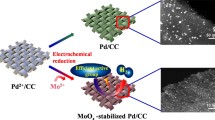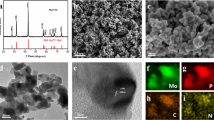Abstract
It is still a great challenge to find highly efficient non-Pt catalysts with good stability for the hydrogen evolution reaction (HER). The molybdenum phosphide (MoP)-based catalysts have been identified as promising candidates to replace noble Pt, but the further improvement of these catalysts is still strongly demanded. Herein, a simple strategy to enhance the HER activity of the MoP catalyst has been proposed, in which a novel MoP/C hybrid is prepared by a facile temperature-programmed reduction method with the modification of Ketjen Black, exhibiting superior HER activity with a smaller Tafel slope of 54 mV dec−1 and a larger current density of 151 mA cm−2 at −400 mV, about 34 times larger than that of the pure MoP catalyst. Moreover, a possible improvement mechanism was also stated.




Similar content being viewed by others
References
He Z, Que W (2015) Molybdenum disulfide nanomaterials: structures, properties, synthesis and recent progress on hydrogen evolution reaction. Appl Mater Today 3:23–56
Liu Q, Tian JQ, Cui W, Jiang P, Cheng NY, Asiri AM, Sun XP (2014) Carbon nanotubes decorated with CoP nanocrystals: a highly active non-noble-metal nanohybrid electrocatalyst for hydrogen evolution. Angew Chem Int Ed 126:6828–6832
Chia X, Eng AYS, Ambrosi A, Tan SM, Pumera M (2015) Electrochemistry of nanostructured layered transition-metal dichalcogenides. Chem Rev 115:11941–11966
Voiry D, Yamaguchi H, Li J, Sliva R, Alves DCB, Fujita T, Chen M, Asefa T, Shenoy VB, Eda G, Chhowalla M (2013) Enhanced catalytic activity in strained chemically exfoliated WS2 nanosheets for hydrogen evolution. Nat Mater 12:850–855
Li S, Wang S, Tang D, Zhao W, Xu H, Chu L, Bando Y, Golberg D, Eda G (2015) Halide-assisted atmospheric pressure growth of large WSe2 and WS2 monolayer crystals. Appl Mater Today 1:60–66
Faber MS, Jin S (2014) Earth-abundant inorganic electrocatalysts and their nanostructures for energy conversion applications. Energy Environ Sci 7:3519–3542
Wu Z, Fang B, Wang Z, Wang C, Liu Z, Liu F, Wang W, Alfantazi A, Wang D, Wilkinson D (2013) MoS2 nanosheets: a designed structure with high active site density for the hydrogen evolution reaction. ACS Catal 3:2101–2107
Wu Z, Tang C, Zhou P, Liu Z, Xu Y, Wang D, Fang B (2015) Enhanced hydrogen evolution catalysis from osmotically swollen ammoniated MoS2. J Mater Chem A 3:13050–13056
Kibsgaard J, Jaramillo TF (2014) Molybdenum phosphosulfide: an active, acid-stable, earth-abundant catalyst for the hydrogen evolution reaction. Angew Chem Int Ed 53:14433–14437
Xiao P, Sk MA, Thia L, Ge XM, Lim RJ, Wang JY, Lim KH, Wang X (2014) Molybdenum phosphide as an efficient electrocatalyst for the hydrogen evolution reaction. Energy Environ Sci 7:2624–2629
Kibsgaard J, Tsai C, Chan K, Benck JD, Nørskov JK, Pedersen FA, Jaramillo TF (2015) Designing an improved transition metal phosphide catalyst for hydrogen evolution using experimental and theoretical trends. Energy Environ Sci 8:3022–3029
Tang C, Sun A, Xu Y, Wu Z, Wang D (2015) High specific surface area Mo2C nanoparticles as an efficient electrocatalyst for hydrogen evolution. J Power Sour 296:18–22
Ledendecker M, Calderón SK, Papp C, Steinrük HP, Antonietti M, Shalom M (2015) The synthesis of nanostructured Ni5P4 films and their use as a non-noble bifunctional electrocatalyst for full water splitting. Angew Chem 127:12538–12542
Chen X, Wang D, Wang Z, Zhou P, Wu Z, Jiang F (2014) Molybdenum phosphide: a new highly efficient catalyst for the electrochemical hydrogen evolution reaction. Chem Commun 50:11683–11685
Xing Z, Liu Q, Asiri AM, Sun X (2014) Closely interconnected network of molybdenum phosphide nanoparticles: a highly efficient electrocatalyst for generating hydrogen from water. Adv Mater 26:5702–5707
McEnaney JM, Crompton JC, Callejas JF, Popczun EJ, Biacchi AJ, Lewis NS, Schaak RE (2014) Amorphous molybdenum phosphide nanoparticles for electrocatalytic hydrogen evolution. Chem Mater 26:4826–4831
Wu AP, Tian CG, Yan HJ, Jiao YQ, Yan Q, Yang GY, Fu HG (2016) Hierarchical MoS2@MoP core–shell heterojunction electrocatalysts for efficient hydrogen evolution reaction over a broad pH range. Nanoscale 8:11052–11059
Wang DZ, Zhang DZ, Tang CY, Zhou P, Wu ZZ, Fang BZ (2016) Hydrogen evolution catalyzed by cobalt-promoted molybdenum phosphide nanoparticles. Catal Sci Technol 6:1952–1956
Wang D, Zhang X, Shen Y, Wu Z (2016) Ni-doped MoS2 nanoparticles as highly active hydrogen evolution electrocatalysts. RSC Adv 6:16656–16661
Liang X, Zhang D, Wu Z, Wang D (2016) The Fe-promoted MoP catalyst with high activity for water splitting. Appl Catal A 524:134–138
Cui W, Liu Q, Xing Z, Asiri AM, Alamry KA, Sun X (2015) MoP nanosheets supported on biomass-derived carbon flake: one-step facile preparation and application as a novel high-active electrocatalyst toward hydrogen. Appl Catal B 164:144–150
Wang L, Sofer Z, Luxa J, Pumera M (2015) Mo x W1−x S2 solid solutions as 3D electrodes for hydrogen evolution reaction. Adv Mater Interfaces 2:201500041
Yan HJ, Jiao YQ, Wu AP, Tian CG, Zhang XM, Wang L, Ren ZY, Fu HG (2016) Cluster-like molybdenum phosphide anchored on reduced graphene oxide for efficient hydrogen evolution over a broad pH range. Chem Commun 52:9530–9533
Marcos LS, Primo A, García H (2013) P-doped graphene obtained by pyrolysis of modified alginate as a photocatalyst for hydrogen generation from water–methanol mixtures. Angew Chem Int Ed 52:11813–11816
Mérela P, Tabbalb M, Chakera M, Moisaa S, Margotc J (1998) Direct evaluation of the sp3 content in diamond-like-carbon films by XPS. Appl Surf Sci 136:105–110
Lee JS, Park GS, Kim ST, Liu ML, Cho J (2013) A highly efficient electrocatalyst for the oxygen reduction reaction: N-doped Ketjen Black incorporated into Fe/Fe3C-functionalized melamine foam. Angew Chem 125:1060–1064
Kim DS, Park YJ (2014) A simple method for surface modification of carbon by polydopamine coating for enhanced Li–air batteries. Electrochim Acta 132:297–306
Zhou JH, Sui ZJ, Zhu J, Li P, Chen D, Dai YC, Yuan WK (2007) Characterization of surface oxygen complexes on carbon nanofibers by TPD, XPS and FT-IR. Carbon 45:785–796
Bai J, Li X, Wang AJ, Prins R, Wang Y (2013) Different role of H2S and dibenzothiophene in the incorporation of sulfur in the surface of bulk MoP during hydrodesulfurization. J Catal 300:197–200
Wang T, Du K, Liu W, Zhu Z, Shao Y, Li M (2015) Enhanced electrocatalytic activity of MoP microparticles for hydrogen evolution by grinding and electrochemical activation. J Mater Chem A 3:4368–4373
Ilangovan G, Pillai KC (1997) Electrochemical and XPS characterization of glassy carbon electrode surface effects on the preparation of a monomeric molybdate(VI)-modified electrode. Langmuir 13:566–575
Whiffen VML, Smith KJ (2010) Hydrodeoxygenation of 4-methylphenol over unsupported MoP, MoS2, and MoO x catalysts. Energy Fuels 24:4728–4737
Acknowledgements
Financial supports from the National Natural Science Foundation of China (Grant Nos. 51302326 and 51572301) and the Hunan Provincial Natural Science Foundation of China (Grant No. 2016JJ3153) are gratefully acknowledged.
Author information
Authors and Affiliations
Corresponding author
Rights and permissions
About this article
Cite this article
Wang, D., Shen, Y., Zhang, X. et al. Enhanced hydrogen evolution from the MoP/C hybrid by the modification of Ketjen Black. J Mater Sci 52, 3337–3343 (2017). https://doi.org/10.1007/s10853-016-0621-1
Received:
Accepted:
Published:
Issue Date:
DOI: https://doi.org/10.1007/s10853-016-0621-1




